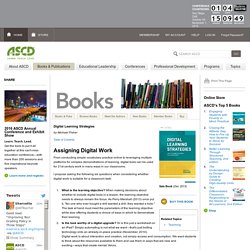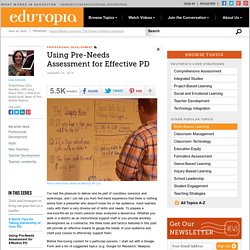

Assigning Digital Work. From conducting simple vocabulary practice online to leveraging multiple platforms for complex demonstrations of learning, digital tools can be used for 21st century work in many ways in our classrooms.

I propose asking the following six questions when considering whether digital work is suitable for a classroom task: What is the learning objective? When making decisions about whether to include digital tools in a lesson, the learning objective needs to always remain the focus. As Perry Marshall (2013) once put it, "No one who ever bought a drill wanted a drill, they wanted a hole. " The task at hand must meet the parameters of the learning objective while also offering students a choice of ways in which to demonstrate their learning.
Here's an example of effectively using technology in class after careful consideration of the above six questions. Here is how we might apply our six key questions to the example of iPad word-fluency apps: What is the learning objective? Here's an example. Using Pre-Needs Assessment for Effective PD. I've had the pleasure to deliver and be part of countless sessions and workshops, and I can tell you from first-hand experience that there is nothing worse than a presenter who doesn't know his or her audience.

Adult learners carry with them a very diverse set of skills and needs. To prepare a one-size-fits-all (or most) session does everyone a disservice. Whether you work in a district as an instructional support staff or you provide ancillary development as a contractor, the three tools and tactics featured in this post will provide an effective means to gauge the needs of your audience and chart your course to effectively support them. Before fine-tuning content for a particular session, I start out with a Google Form and a list of suggested topics (e.g. Google for Research, Nearpod, Kahoot, Student Projects with iPad, Workflow with eBackpack) that I perceive to be campus or department needs. Google Forms I find these are best used with longer workshop sessions.
Examples: What Is Successful Technology Integration? Technology integration is the use of technology resources -- computers, mobile devices like smartphones and tablets, digital cameras, social media platforms and networks, software applications, the Internet, etc. -- in daily classroom practices, and in the management of a school. Successful technology integration is achieved when the use of technology is: Routine and transparent Accessible and readily available for the task at hand Supporting the curricular goals, and helping the students to effectively reach their goals.
Why Do We Need Technology Integration? Technology is a ubiquitous part of children's lives.

It is transparent. Most homes have connected computers or Internet-enabled devices. As prices of technology drop, computers and digital devices may replace television as we know it. When pioneering educational technology advocate Jan Hawkins wrote an essay for Edutopia in 1997, "The World at Your Fingertips: Education Technology Opens Doors," about how technology brings the tools of empowerment into the hands and minds of those who use them, she couldn't have known her words would be even more relevant today.
Now, walk into a classroom. NatureMapping brings real science to the classroom with hand-held data collection devices. Individualized Technology Goals (ITGs) for Teachers: A Fable of the Staff Development with No Clothes. In a public school kingdom, the school year started typically for the instructional technology department, with a daylong meeting about school year requirements.

This included a list of trainings the campus technology instructional specialists (TIS) were obligated to offer. As one lowly TIS looked over the list, she saw that many of the trainings did not apply to her campus. Her teachers needed her help with integration, not the technology itself. Basically, she felt that the list -- created by a district over-reliant on the group training model for a certain software or technology tool without including integration ideas -- did not reflect the needs of the teachers on her campus.
After all, wasn't she an integration specialist? That TIS did not shout. Several changes have been made to keep the plan continuously improving, but now in its third year of implementation, the following basics are currently being implemented in this district. The ITG Plan Plan Notes Reflection. What Does Transformational Teaching Look Like? Developing a Growth Mindset in Teachers and Staff. The New Psychology of Success (2000), Dweck developed a continuum upon which people can be placed, based upon their understandings about where ability comes from. For some people (at one end of said continuum), success (and failure) is based on innate ability (or the lack of it). Deck describes this as a fixed theory of intelligence, and argues that this gives rise to a ‘fixed mindset’.
At the other end of the continuum are those people who believe success is based on a growth mindset. These individuals argue that success is based on learning, persistence and hard work. According to Dweck: In a fixed mindset students believe their basic abilities, their intelligence, their talents, are just fixed traits. The crucial point for individuals is that these mindsets have a large impact upon our understanding of success and failure.
Needless to say, this idea of mindsets has significant implications for education. Crucially, Dweck’s research is applicable to all people, not just students. Using Pre-Needs Assessment for Effective PD.